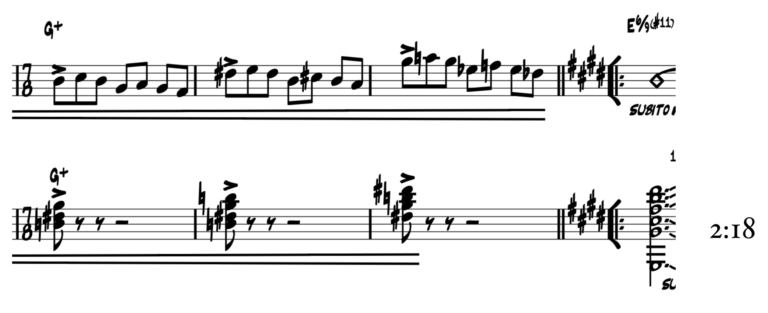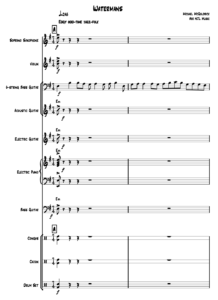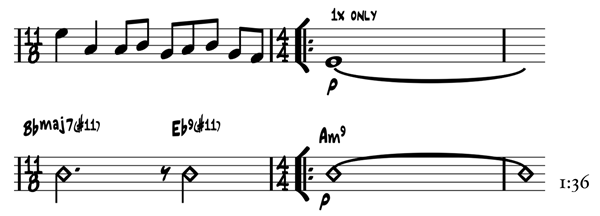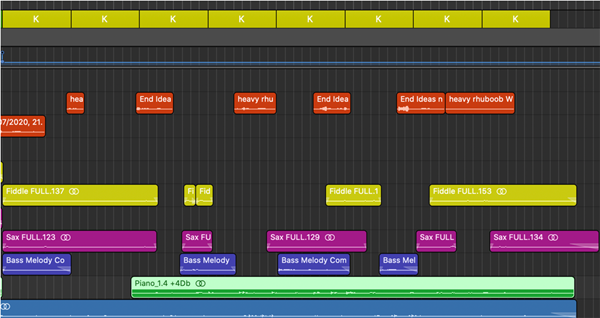Watermans pt 2 - A Commentary
Context
'Watermans' was written by flautist Michael McGoldrick and released on his first solo album Fused - Vertical Records VERTCD051 (2000), an album that received critical acclaim.
"[Fused] is a masterpiece, mixing traditional with trance and fusion."
Michael McGoldrick is a household name in Folk music and is associated with numerous most-excellent acts and artists within the genre a co-founder of the ensembles Flook and L├║nasa, and a core member of Capercaillie. If you haven't heard of his music, check it out!
Supposedly McGoldrick was inspired by the rhythms and harmonies he heard in the middle East after a trip there. The result was a tune that has since become a staple tune at his concerts and a favourite among contemporary folk enthusiasts. Although the original release of Watermans has a relatively relaxed feel, when performing live in his small ensembles he generally opts for a much faster and aggressive rendition, allowing space for his virtuosic embellishment.
I first heard this tune back in 2008 shortly after I joined contemporary folk trio and winners of the 2002 BBC young folk musicians of the year award, Uiscedwr. The tune formed part of their debut album Everywhere (2004) and occasionally made it into their live set. I enjoyed its twists and turns and simple minor harmony, it had a great melody and plenty of scope for rhythmic and harmony play. I remember being inspired by the sheer fun of the tune and the delight it brought audiences but it wasn't until recently I would attempt to recreate it for myself and Second Circle.
Alongside this commentary is a full score which you can download here. Within this article I will refer to section marks within the score. You can watch the video of the piece here.
Form
Watermans is in E minor, has a 7/8 time signature at approx 8th note=204bpm and two main sections (A, B) with a third (C) that acts as a vamped coda in 6/8. This third section is used more as a respite opportunity in his live situations and a chance to change the dynamic before launching into another rendition of the main AB tune, but in the recording on Fused it acts as a slow fade-out transition to the next tune on the record.
The C section has been removed in the Second Circle arrangement, but the premise of utilising a dynamic change to shift from high-intensity to low-intensity to break up the dichotomy of the mainly AB form remains through shorter intermediary sections. Such as in the sections with the Cajon solo, 4/4 A Minor section and the Coda - modulating to E Major.
I will discuss these ideas and the creative decisions in more detail later, but first let's generally compare the from of the two arrangements. In a similar way to McGoldrick, and to many folk tune arrangements, the whole tune acts as a sort of 'pivot-point', where tune often stays the same (with mild variation and idiosyncratic embellishes) but with dynamic harmonic, rhythmic and textural changes occurring around/underneath it. Below is a comparison chart of when the main tune is performed and by which instruments for the two arrangements.
In the following comparison I am by no means suggesting the SC arrangement is 'better' than McGoldrick's in any way. They are completely different approaches. I have chosen to adapt the arrangement to reflect my own personal tastes and musical heritage and to suit a much more aggressive and relentless rendition of the tune both harmonically and rhythmically. McGoldrick's tempo is 4th note = 206bpm. Our tempo is 4th note=245bpm
The following headings indicate the tune part A/B/C, section marker from the score (A/B/C...) and, the audio time stamp.
A (A) - 0:00
Firstly, I opted to forge an introduction. In essence the first A and B sections act as the introduction. The statement of the tune was to be the first thing to be heard along with a gut-punch from the band to wake up any unsuspecting listeners. The ensemble defines the downbeat anchoring the start of the phrases whilst reflecting the original harmony offered by McGoldrick: Em, Am, D (i - iv - bV), although the Am is substituted for C.
B (B) - 0:14
The rest of the ensemble enter creating a texture suggesting an Aminor tonality rather than the original Eminor key centre. The harmony builds with the dynamic that leads us into Eminor proper in the next A section. Here we hear the general feel of the 7/8 by the percussion section.
A (C) - 0:27
Acoustic guitar and bass play the tune 2 octaves apart are supported by some other-worldly effects on the violins and electric guitar harmonics, again creating a rather ambiguous harmonic texture this time around Eminor
B (D) - 0:41
The violin joins in on the tune and we hear clearly defined harmonic movement and rhythm of one-chord-per-bar moving to a slower one-chord-per-two-bars after an ensemble-wide rhythmic figure. We hear a similar sax & violin rise that we heard in the first B building and leading us to the next section
Cajon Solo (E) - 0:55
We return to similar ensemble stabs to what we heard in the first statement of the tune, this time with more complexity and syncopation across the 7/8 time feel and a short 'turn-around 'to highlight the downbeat and restart of the phrase. These act as strong and sparse pillars of syncopation to prop up the cajon improvisation, we all need some sort of grounding right?!
A - Cajon Solo Cont (F) - 1:08
The cajon continues along with our aforementioned ensemble stabs. The acoustic guitar quietly states the A tune in the background.
B (G) - 1:22
A short and biting soli of the B tune by the bass, guitars, violins, piano, and saxophone immediately occur after the close of the cajon solo which perhaps gives a false sense of security as the supporting ensemble returns 2 bars later. A trick often used in South American music to great effect where instead of fills at the end of sections into the next, the 'fill' comes on the start of the new section delaying the gratification of the release.
C (H) - 1:35
The respite. As in McGoldrick's version the coda leaves us with a release from the repetition of the tune here I chose our rest to be in harmony and rhythm. We leave the unsymmetrical 7/8 for a steady 4/4 and return to the Am (dorian) tonality from the first B; together creating a soft harmonic and rhythmic rest from the franticness of the 7/8 and edgy Em harmony. The melodic bass improvises a short phrase and the supporting bass sets up a rhythmic pedal that will continue into the return of the 7/8 in the next section.
B (I) - 1:43
The acoustic guitar carries the tune over the Em harmony and bass cross-rhythm pedal. Halfway through this section we get some 'jazz' harmony that was inspired by and in some parts, lifted from the changes of Richard Rogers' My Favourite Things.
A (J) - 1:57
The final climatic rendition of the tune! The tune is played by the acoustic guitar, bass, 2 violins and the soprano sax starting in a set of trades over the phrases before all coming together in a final statement. The last part of the last phrase is repeated under a strongly defined and stabbed G augmented chord creating a final concoction of harmonic and rhythmic dissonance before crashing through the section barrier to fallout the other side into...
Coda (K) - 2:20
A lush, warm and resolution to E Major (Lydian). Space from groove and rhythm - although the 7/8 subtly persists underneath. Eventually, a soft 7/8 samba groove establishes itself and all the melodic instruments improvise short phrases around each other.
Harmony
McGoldrick's original recording of Watermans utilised relatively simple harmony based around the key centre of E natural minor (Aeolian) and predominantly utilises chords Iminor and IVminor throughout. The final C section (Coda) stays on the minor tonic. Often in live shows the harmony is adapted to contain more movement modulating to the relative major Imaj7 & IVmaj7 (1:44 in this video).
Harmony in the Second Circle arrangement was to play a vital part in creating alternate textures and in doing so I hoped to test how far I could go before sacrificing the impact of the tune, which in Folk music, is paramount, an importance I hoped to retain.
We generally keep to the original key of E Minor in terms of the melodic expression except a brief adaptation to whole tone harmony over G+ in bars 79-81 (J) serving as a final act of dissonance prior to the resolution into E Major.

The main alterations of harmony occur throughout with a few recurring themes:
A 'jazzier' take on the classic Andalusian Cadence: i - bVII - VI - V (D);

Slash chords based on bVII/I, III/I, I/II as percussive hits for the cajon solo backing (E);
Resolution to the Subdominant instead of the Tonic: bV^7 - bI7 - iv7 (H);
iv - V7 - i - into chromatic descending bass (G);
Alternating between Aeolian and Dorian sounds in the harmony with Cb in the C^7#11/E and C# in the A7/E;
Even when the melody technically doesn't suit, i.e. Cb over a A7 creating a momentary A7#9;
And finally, utilising some standard jazz cyclical 4ths progressions and minor ii-V-i, followed by slower harmonic movement in descending semi-tones:
Rhythm / Groove
7/8 and 7/4 time signatures usually offer interesting opportunities for cross rhythms. An example in this arrangement is utilising a 3 over 4 feel that begins in the 4/4 section (H) on the bass setting up a subtle pedal tone which continues into (I) the regular 7/4 feel. This was an improvised occurrence that turned into an interesting moment, a happy accident.
Shortly after the pedal is established the rhythm acts as a 'walking bass' line, reflecting the change in harmony to something more akin to the standard jazz canon.
Note here that although the chords notated above are portraying an E pedal when the bass is clearly playing an A pedal. The chord symbols reflect the original instruction given to the piano and guitar when voicing their accompaniment, the effect of the E pedal is obviously diminished with the overriding bass pedal.
The bass pedal in this sense isn't intended to act so much as an underpinning as a pivot point within the harmonic field, the desired effect was to create an ambiguous tonal centre even though chord Iminor is being established, meaning when (J) occurs we get a very strong and definitive modulation to the relative major, Gmajor. The slowing of the harmonic rhythm from (J) is also a deliberate decision to compound this effect of a new chord I.
Rhythmic Play
Odd time signatures often have the sense of 'falling over themselves' or being unsettling. They are rarely used in danceable western popular music, although exceptions such as the asymmetric meters of Balkan folk music and Spanish Buleria do indeed exist. The effect of the down-beat feeling shifted or anticipated can create a perpetual sense of asymmetry. In the realm of jazz ,it is quite common for odd time signatures to be used as a device for its own sake and the emphasis on the 'odd' part of the time is more apparent. This is suggested by the way grooves are organised within these frameworks, the down-beat or beat one, is usually emphasised and exacerbates the 'odd' feeling. In Watermans the tune is very clearly phrased around 7, but I endeavoured to make the accompaniment not sound like it was contrived.
In most cases in this arrangement, the main emphasis on the down-beat is created by the harmonic movement rather than the percussion/drums. This endeavour is also apparent in the cajon solo section (E-F) where the rhythm of the stabs doesn't clearly give away where the changes of bars are until we have come to the end of the 2 or 4 bars of the rhythmic figure.
Later an 11/8 bar is utilised to resolve the melody naturally and away from the typical phrasing in 7. The resolution of the melody occurs a few beats from the end of the form's sequence, the idea was not to have the tune finish and then a few beats later have the change of section but to have the resolution of the section fall exactly on the tunes' last note, essentially cutting the phrase by 3 quavers.
At letter (H) the arrangement shifts into 4/4 very subtly. The rhythm section essentially drops out at this point and the 4/4 is a subtle underpinning that hopefully goes unnoticed, while effectively at releasing some of the rhythmic tension created by the regular 7/4 and one-off 11/8 bars. It is hoped that a brief respite in 4/4 would create a feeling of rhythmic resolution along with the harmonic resolution before launching back into the tune in 7 again, much like the brief pause in a rollercoaster ride before the next drop.
In the coda (K), a similar strategy of resolving rhythmic dissonance was utilised. The 7/4 feel is strongly defined by the slower harmonic movement, becoming pendulum-like as the weight of the harmony swings side to side strongly defining each change in the progression (something that is mirrored by the trading of the melody by the tune carriers).
At the inevitable end of the section the last part of the phrase is repeated twice over a G augmented chord giving us a final piece of rhythmic dissonance and delaying resolution to the downbeat which when it arrives. This is met by an immediate decrease in tempo and a change to 7/8 (and also a harmonic modulation to E Lydian). Similarly, like in letter (H) as the rhythm section doesn't hint at this and pauses, the effect of the shift in time feel and tempo can easily go unnoticed, and when the gentle 7/8 samba groove is established a few bars later it doesn't feel at all out of place and subtly carries the groove forwards.
Bass Melody
Attributing this melody, originally written on a flute, to a stringed instrument will initially introduce technical challenges due to the nature of the ergonomics of the instruments. Indeed, it would with any cross-pollination of music from one instrument to another; however the transposition to the electric bass has arguably more substantial challenges, not in the least the size and scale of the instrument.
The melody itself in its most standard form i.e. with no ornamentation, is relatively straight forward on the electric bass, however, folk tunes are rarely played in such an elementary fashion. The player brings their element of interpretation by supplementing the melody with ornamentation and phasing style. This was the main challenge to overcome.
Folk ornaments from a violin or a flute do not fall so easily on an electric bass, partly due to the difference in note layout and effort required to execute. The tempo of this piece exacerbated the challenge. At relatively slower tempos it is easier to articulate idiomatic folk ornamentations like turns and pull-offs in the two natural positions for playing the melody on the electric bass. However, at faster tempos, decisions were made to facilitate either more idiomatic ornamentation or flow of phrasing.
Performances/Recording
The Second Circle arrangement was recorded individually and remotely presenting unique challenges.
Often in the folk form the tune is of paramount importance and the main tune player will dictate the ebb and flow of time and 'feel'. This wasn't possible to do in this circumstance and in effect the track was recorded and performed backwards. The rhythm section performed to a midi rendering of the piece and the first tune part to be recorded was the acoustic guitar.
Spontaneous interaction is only possible sequentially where the latest musician to record had the advantage of recording to everything previous and therefore had more scope for interpreting their written part in-line with the ensemble outside of arranged interactions.
This became especially tricky for the Coda (K) where the tune players have improvised phrases seemingly one after another, in reality this effect was manufactured due to the timings for the musicians recording and returning their parts. Perhaps in future this could be avoided by better planning the space for the musicians to 'work' in, however, one would still be left with the issue of sequential referential improvisation - the most recent player having more to 'bounce off of'.
To some extent this issue was pre-addressed by requesting tune players instructed to improvise a few lines over the final section, the only exception was the acoustic guitar part which was left in its entirety as Edward instinctively had left plenty of time between his improvised lines to allow other instruments the space. As for the rest of the instruments, I exercised personal preference and choosing lines that matched well to decide which phrases would land where.
In Closing...
This project has been challenging, engaging, a few times infuriating, but mostly an absolute joy all the way from the initial idea to create a unique arrangement of the tune, to practicing the part, recording & editing, video creation, and final release. It has been the kind of undertaking that mirrors that of the proverbial swan (or duck, depending on your level of optimism), on the surface a complete picture of something beautiful, and attempt at art; underneath, is the blood sweat and tears that go into all artistic endeavours.
I've attempted to make this commentary as brief as possible whilst detailing some of the interesting artistic decisions that went into creating Second Circle's rendition of Watermans. Introducing every creative direction taken in this process and subsequently detailing it in enough detail to satisfy my own wants wouldn't be feasible in attempting to create a short commentary of a piece that had so much work and input. Nevertheless, I hope you have found something of interest within these words to take away and apply to your own creative endeavours.
Thank you for reading. If you have any questions or comments please feel free to contact me at nick@nicholasjameswaldock.uk
Links
- Michael McGoldrick's Watermans from 'Fused' on Spotify: https://open.spotify.com/album/2OGJ9gTDTk9LJfesg0wfmY?si=_jeUET5LT2eYjuFesyPHEQ
- Second Circle's recording of Watermans: https://open.spotify.com/album/4l9jc0NC8cbjIESzJb1kV5?si=Qi6cc9S4TzmZ6u4YTnpGWg
- Download the single: Watermans - Second Circle
- Michael McGoldrick performing Watermans at Celtic Connections 2008: https://www.youtube.com/watch?v=7dnnxG_pGw4
- Download the full score PDF here
- https://en.wikipedia.org/wiki/Michael_McGoldrick
- https://michaelmcgoldrick.bandcamp.com/album/fused
- https://en.wikipedia.org/wiki/Uiscedwr
Posted In: News
← Back to Recent Posts















